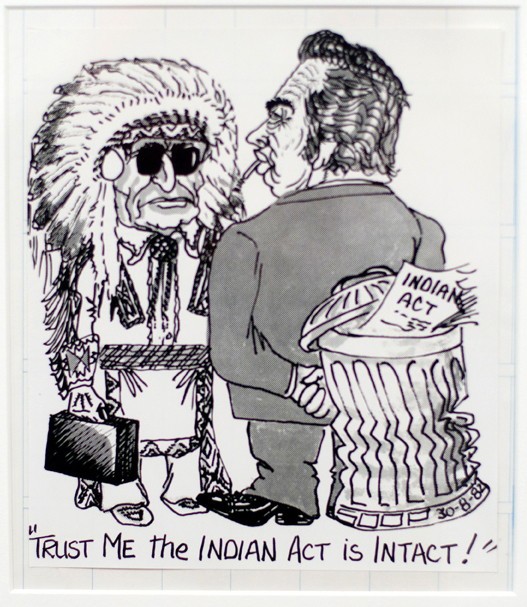Aboriginal cartoonist drew humour
Exhibit celebrates the work of Everett Soop, who lampooned the corrupt, the racist and the ignorant
Faced with life in a wheelchair, artist Everett Soop used his sharp wit to overcome the many disadvantages in his life. Soop, who suffered from muscular dystrophy, created cartoons that combined a dark humour with his advocacy of aboriginal rights, and later, rights for the disabled.
A sample of Soop’s work is presented in Gallery 1C03’s Everett Soop: Journalist, Cartoonist, Activist. Also included in the exhibition, which was circulated by the Nickle Arts Museum of Calgary, are family photos, an election poster from his several years in politics and a large photo of St. Paul’s, the residential school he attended.
While it’s a limited look at an extremely prolific artist – Soop made thousands of cartoons during his lifetime – the exhibition is an entertaining sample of the work of an artist whose national significance has only recently been recognized.
Soop, who died in 2001, grew up on the Blood Indian Reserve in Alberta. In the 1970s he began to work as a cartoonist for the Kainai News, one of the country’s first aboriginal news organizations. It was here that he developed his own unique style of political satire.
One particularly poignant drawing, “Trust me the Indian Act is intact,” deals with the debate during the 1980s surrounding the relationship between Aboriginal People and Canada’s newly amended constitution. In it, Indian Affairs Minister John Munro hides a garbage can containing the Indian Act from the sight of a stereotypically stoic chief.
Soop caricatured both white and native politicians in an equal ruthless manner. In “The professional board member – why work,” for example, a smug looking chief is kissed in suggestive places by his associates.
While his cartoons burned those who abused their responsibilities to society, Soop himself was not a heroic figure. As members of his family pointed out in the exhibition catalogue, he was short-tempered, struggled with alcoholism and had to be looked after constantly towards the end of his life.
Several works expose the darker side of Soop’s life. In “Discrimination,” scratchy pen marks depict a shadowy figure next to the question, “Have you ever experienced the humiliation of unemployment because of discrimination?”
It is the contrast between darkness and humour that makes this exhibition so valuable, and gives Soop’s work lasting political relevance. His cartoons display a uniquely Canadian (specifically, aboriginal) sense of humour and speak to the political issues that directly affected him and his community.
The cantankerous cartoonist once faced becoming, in his words, “vegetable Soop.” Instead, he created a huge body of work lampooning the corrupt, the racist and the ignorant, with an incredible amount of ability.
Everett Soop: Journalist, Cartoonist, Activist is on display until Apr. 4. On Thursday, Mar. 19, 2009, Gallery 1C03 co-presents Humour in Indigenous Cultures at 6:30 p.m. in Convocation Hall at the U of W. The evening includes stand-up comedy, storytelling, critical thinking and laughter inspired by the life and work of Soop. This event is free and open to the public.
Published in Volume 63, Number 24 of The Uniter (March 19, 2009)








